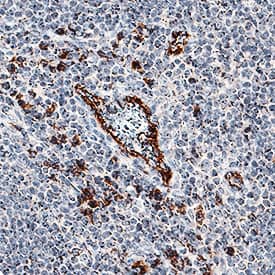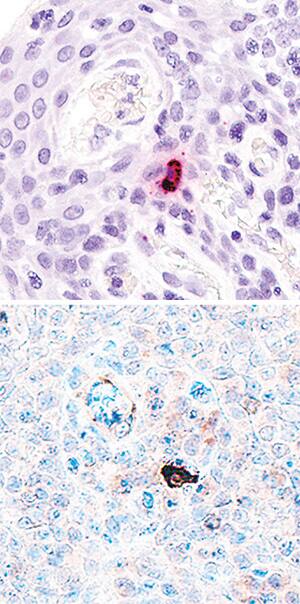Human/Primate IL-17F Antibody
R&D Systems, part of Bio-Techne | Catalog # AF1335


Key Product Details
Validated by
Species Reactivity
Validated:
Cited:
Applications
Validated:
Cited:
Label
Antibody Source
Product Specifications
Immunogen
Arg31-Gln163
Accession # AAK83350
Specificity
Clonality
Host
Isotype
Scientific Data Images for Human/Primate IL-17F Antibody
IL‑17F in Human Tonsil.
IL-17F was detected in immersion fixed paraffin-embedded sections of human tonsil using Goat Anti-Human/Primate IL-17F Antigen Affinity-purified Polyclonal Antibody (Catalog # AF1335) at 3 µg/mL for 1 hour at room temperature followed by incubation with the Anti-Goat IgG VisUCyte™ HRP Polymer Antibody (Catalog # VC004). Before incubation with the primary antibody, tissue was subjected to heat-induced epitope retrieval using Antigen Retrieval Reagent-Basic (Catalog # CTS013). Tissue was stained using DAB (brown) and counterstained with hematoxylin (blue). Specific staining was localized to extracellular space and plasma membrane. View our protocol for IHC Staining with VisUCyte HRP Polymer Detection Reagents.IL-17F in Human Tonsil Using Dual RNAscope®ISH and IHC.
IL-17F mRNA was detected in formalin-fixed paraffin-embedded tissue sections of human tonsil probed with ACD RNAScope® Probe (Catalog # 310941) and stained using ACD RNAscope® 2.5 HD Detection Reagents-Red (top image, Catalog # 32260). Adjacent tissue section was processed for immunohistochemistry using R&D Systems Goat Anti-Human IL-17F Antigen Affinity-purified Polyclonal Antibody (Catalog # AF1335) at 3 ug/mL for 1 hour at room temperature followed by incubation with the Anti-Goat IgG VisUCyte HRP Polymer Antibody (R&D Systems, Catalog # VC004) and DAB chromogen (lower image, yellow-brown). Tissues were counterstained with hematoxylin (blue).Applications for Human/Primate IL-17F Antibody
Dual RNAscope ISH-IHC Compatible
Sample: Immersion fixed paraffin-embedded sections of human tonsil
Immunocytochemistry
Sample: Immersion fixed human peripheral blood mononuclear cells treated with PMA and ionomycin.
Immunohistochemistry
Sample: Immersion fixed paraffin-embedded sections of human tonsil
Western Blot
Sample: Recombinant Human IL-17F (Catalog # 1335-IL)
Human/Primate IL-17F Sandwich Immunoassay
Reviewed Applications
Read 1 review rated 5 using AF1335 in the following applications:
Formulation, Preparation, and Storage
Purification
Reconstitution
Formulation
Shipping
Stability & Storage
- 12 months from date of receipt, -20 to -70 °C as supplied.
- 1 month, 2 to 8 °C under sterile conditions after reconstitution.
- 6 months, -20 to -70 °C under sterile conditions after reconstitution.
Background: IL-17F
The Interleukin 17 (IL-17) family proteins, comprising six members (IL-17A through IL-17F), are secreted, structurally related proteins that share a conserved cystine-knot fold near the C-terminus, but have considerable sequence divergence at the N-terminus. With the exception of IL-17B, which exists as a non-covalently linked dimer, all IL-17 family members are disulfide-linked dimers. IL-17 family proteins are pro-inflammatory cytokines that induce local cytokine production and are involved in the regulation of immune functions (1, 2).
Human IL-17F cDNA encodes a 163 aa protein with a putative 30 aa signal peptide. Among IL-17 family members, IL-17F is most closely related to IL-17A (approximately 44% aa sequence homology), but shares only limited sequence homology (16 - 30%) with IL-17B, C, D and E. Human and mouse IL-17F share 55% sequence identity. IL-17F is expressed in activated CD4+ T-cells and activated monocytes. Five receptors (IL-17 RA, B, C, D and E) have been identified (5). Although the ligands for IL-17 RD and E are not known yet, it is reported that IL-17 RA binds IL-17A, and IL-17 RB binds IL-17B and IL-17E. IL-17 RC binds IL-17A and IL-17F with similarly high affinity and functions as a receptor for both IL-17A and IL-17F (5, 6). The biological activities mediated by IL-17F are similar to those of IL‑17. IL‑17F stimulates production of IL-6, IL-8, G-CSF, and regulates cartilage matrix turnover by increasing matrix release and inhibiting new matrix synthesis (4). IL‑17F also inhibits angiogenesis and induces production of IL-2, TGF-beta, and monocyte chemoattractant protein-1 in endothelial cells (3).
References
- Aggarwal, S. and A.L. Gurney (2002) J. Leukoc. Biol. 71:1.
- Moseley, T.A. et al. (2003) Cytokine & Growth Factor Rev. 14:155.
- Starnes, T. et al. (2001) J. Immunol. 167:4137.
- Shen, F. & S. L. Gaffen (2008) Cytokine 41:92.
- Kuestner, R.E. et al. (2007) J. Immunol. 179:5462.
Long Name
Alternate Names
Gene Symbol
UniProt
Additional IL-17F Products
Product Documents for Human/Primate IL-17F Antibody
Product Specific Notices for Human/Primate IL-17F Antibody
For research use only
